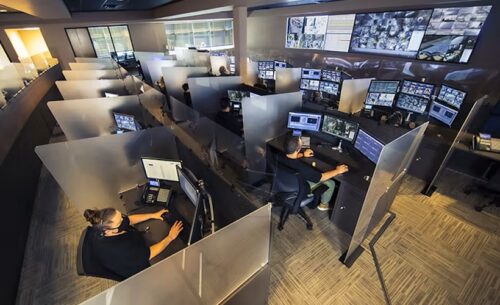
10.12.22 – SIW – Woodie Andrawos
Proactive video monitoring, or PVM, is one of several emerging solutions available to security providers
Throughout the past two years, organizations around the globe have increased their reliance on video surveillance. The explanation as to why is somehow simple and intricate all at once: Video has become the source of advanced security and operational insights that enable leaders to adapt to the contemporary business environment. With this, the industry is seeing several trends hitting the market today, and below we will dive into a few of them in more detail.
Increased Market Adoption
If the last few years have taught the industry anything, it’s that threats are always evolving, and with crime skyrocketing in cities across the United States, individuals and organizations are combatting this by upgrading security infrastructure. According to a report by Research and Markets, the global video surveillance market is expected to reach $69.4 billion by the end of 2026 and is growing at a CAGR of 10.2 percent.
Security, alarm, and video monitoring have always been a staple in the industry. Video surveillance, in particular, has always been a valuable solution used to investigate a crime after the fact. But to combat rising threats, the market must evolve alongside it, and many organizations are now choosing to use innovative, proactive solutions that can even stop crime before it happens. Proactive video monitoring, or PVM, is one of these emerging offerings. It accomplishes this by drawing immediate attention to unauthorized activity, allowing the video monitoring provider to intervene and notify local authorities before a crime can occur. Beyond that, PVM offers live intervention, not pre-recorded messages, from intervention specialists in a central monitoring station.
Additionally, central monitoring stations offer numerous services, such as instant emergency help, round-the-clock coverage, and incident reporting. Seeking out monitoring centers that offer Proactive Video Monitoring (PVM) is also beneficial and cost-effective for the user, as it can provide stability in an otherwise uncertain economic climate. With rising inflation, crime, and economic downturn, businesses losing valuable assets to crime can have devastating effects. For companies facing financially uncertain times, knowing that property and assets are safely guarded can make all the difference in the world.
Dealers Building RMR
In recent years, many dealers in the alarm industry have learned how to create recurring monthly revenue (RMR) from video monitoring, especially with PVM. RMR serves as a valuable addition to the average business model for alarm businesses and other companies in the security sector – especially for those that may have fallen on challenging times within the current economic climate. RMR is a business model uniquely lucrative for businesses in the security industry – seemingly more so than businesses in other markets.
The core value of the RMR business model is the idea that in the current state of the industry, the ability to provide a valuable ongoing service to customers is just as important as developing and selling tangible products. Additionally, the service-centric business model tends to provide a stable, predictable monthly income for businesses that utilize it. This makes planning and budgeting simpler and, as a bonus, helps maintain repeat clients. In most cases, this is why RMR is witnessing a steadily increasing adoption rate amongst respective businesses in the industry.
Higher Demand for Intelligence
One feature that traditional video monitoring forms have lacked until recently is intelligence. In the past, video monitoring was used merely to rewind and review footage to determine what exactly happened on-camera, which lacked an active and intelligent presence to make sense of and respond to what was happening, be it a human presence or machine learning software. In recent years, however, the demand for an intelligent presence has skyrocketed in the surveillance industry – specifically regarding artificial intelligence (AI).
In fact, the demand for intelligence in video monitoring has become so prevalent that the AI CCTV market value is expected to rise from $14.99 billion in 2021 to $51.95 billion in 2030. This demand for intelligent video is not unwarranted, as AI is expected to improve the surveillance experience by automatically identifying people, vehicles, events, and other aspects of surveillance that will improve response times and preventative measures.
In conclusion, the expectations surrounding video are constantly growing. More organizations are seeking solutions that sustain intelligent processes across their infrastructure. AI is rising to the forefront to aid in stopping crime, and RMR has seen a significant boost as more dealers are taking advantage of solutions like PERS and Proactive Video Monitoring (PVM). With rapid technological advancements, those in the industry aspire to keep up to speed. Still, it’s important to note that even with all of these changing trends, safety remains the highest priority. Because of this, video surveillance partnerships, integrations, and innovations will constantly grow, and security will forever be moving forward.

About the author: Woodie Andrawos started his career in the alarm industry in 1992 working for National Alarm Computer Center (NACC) in their business office, moving his way up to Billing and Credit Manager and as VP of Finance. In June 2001, Woodie Andrawos and Michael Shubert founded National Monitoring Center (NMC). In its first year of operations, NMC added 40,000 accounts and brought on new technologies that enabled the new monitoring center company to continue accelerated growth for many years. In 2007, he opened the company’s second monitoring center in Irving, Texas. In 2012, Woodie and his partners bought a 25,000 square foot building in Lake Forest, Calif., and built a state-of-the-art monitoring center and moved the business there in 2014.
